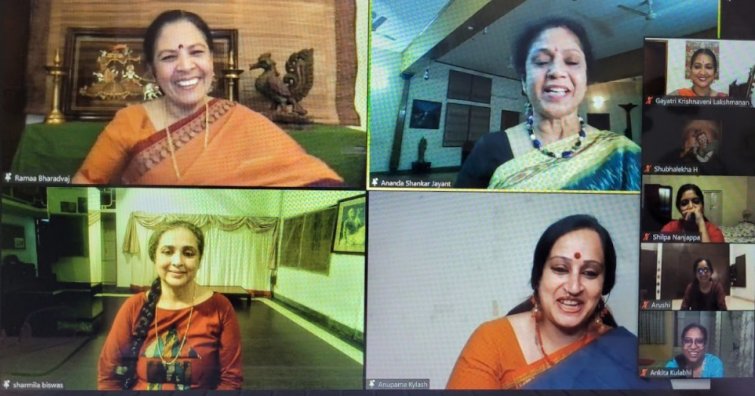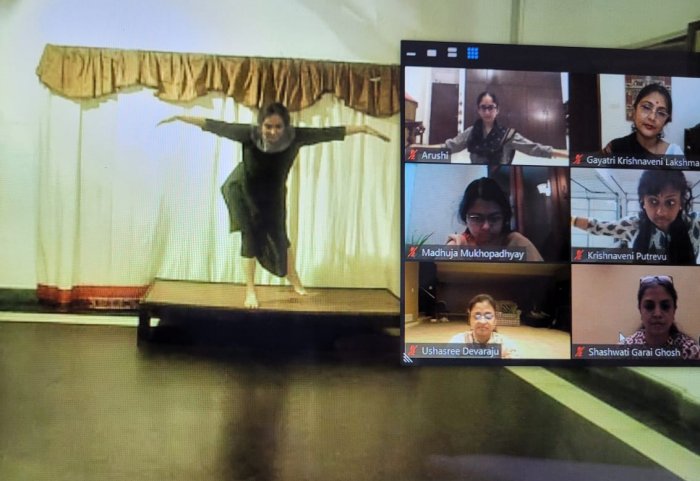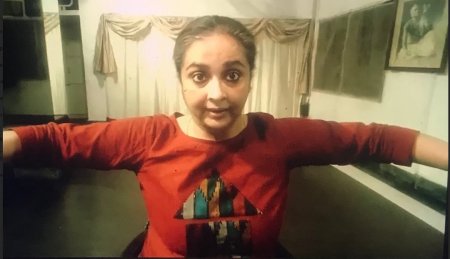
|   |

|   |
An immersive experience of Odissi, on the immortal verses of saint poet Annamacharya - Swapnokalpa Dasgupta e-mail: swapnokalpa@yahoo.com April 3, 2022 Sitting far away in Mumbai and getting to learn from stalwarts across India is an exceptional opportunity that the pandemic has gifted us. Never before did we artistes experiment and devote our energy to this new learning/performing stage the way we do now and never before did we students get such exceptionally curated learning exercises. Experiences of being a part of the 9th session of Tamrapatra, skillfully crafted by Dr Ananda Shankar Jayant, her collaborator Dr. Anupama Kylash, and their team was overwhelming and inspiring. Nearly a year back, Tamrapatra, a yearlong exploration of some of the rare creations of the saint poet Annamacharya (born 1408 AD), who had created around thirty two thousand Sankeertanas or songs in praise of Lord Venkateswara, was announced by Natyarambha. As a programmer, I was intrigued to observe how they retain the attention of participants for such a long duration. In an age of our attention span reducing day by day and with waves of hope opening doors to physical events and the outdoor world, keeping the audience engaged over one year for an online presentation is quite a task. As I glanced through the numerous eager faces that shone through their windows on the screen, I was happy and proud of being a part of this community of serious learners and devotees of the art.  Day 1 started with a very eloquent Dr Jayant introducing the great poet and his works to the participants who had come from various dance backgrounds. She explained that in 1922 few of these great works were found on copper (tamra) plates (patra) and the Tirumala Tirupati Devasthanam (TTD) had created almost 29 volumes of works which were set to music by great musicians. In 2010, the young and talented Sathiraju Venumadhav chose 108 of these exceptional uncomposed verses and this work was released by a production house in Hyderabad. 108 different ragams were used to create these 108 unique songs. Unfortunately, Sathiraju Venumadhav passed away and Dr. Jayant's Shankarananda Kalakshetra took upon themselves, this great and noble task of creating a unique yearlong learning of the creations through Tamrapatra series where 12 of the great works are being explored by senior dance artistes from across the forms. In most of the classical dance forms of India, we see works that are mostly on the local language of the area from where the dance form is and Sanskrit. Creations in other Indian languages have not been very widely practiced other than in communities Eg. Abhanga in Maharashtra and Tagore songs among Bengalis. This exercise of involving different dance styles to innovate with poetry in Telugu will make them more accessible to a wider and variety of audiences. The fact that our senior dance exponents are endorsing the idea of this cultural exchange would encourage more artistes to experiment with poetry in languages across India, thereby creating more audiences for the forms. But how do we treat a different genre of music and words? Till where do we depart and how do we mould? These answers were clearly explained in this exceptional sharing by Sharmila Biswas and other seniors. The context behind the golden words of the sankeertana was soulfully explained to us by noted scholar and dancer Dr. Anupama Kylash. She said that, interestingly only 4-5 volumes of the 29 volumes of sankeertanas published by the TTD are based on "Adhyatma" and the rest of the volumes are primarily "Shringara". While explaining the different categories that are associated with the Adhyatmic works of the poet, Dr Kylash highlighted that there is constant interplay between Adhyatma and Shringara in the poet's works. She explained the beautiful poetic images created through categories like Alankara Priya Venkateswara (adornments of Venkateswara) where the camphor adorning the Lord's body is equated to the froth of the ocean or when a bejeweled Lord stands with his Lakshmi, it feels like he has covered himself with his beloved. Dr Kylash went on to explain many other category of songs that are found like Rupalila Varnanas where the deeds and tales of greatness are sung of all the Godheads of Vaishnavism - Vishnu, Krishna, Ram and Venkateswara, the rustic songs of the fortune tellers, the songs sung during processions, songs that are used to wake up the divinity. The purely philosophical or Adhyatma section starts with vairagya (dis-attachment) that questions the very purpose of a being in this world leading to section on Saranagati and lyrical masterpieces with alternate lines in Sanskrit and Telugu. The poet's work is inclusive as it includes all philosophical paths and not only Vishishta Advaita, the school of philosophy he believed in. After composing thousands of great works, the poet finally says: Only one Sankeertana has the power to make us understand your greatness, the rest can be hidden. With this line Dr Kylash takes us to the context of the song selected for the choreography and the Tamrapatra session. The life that we live is a drama and with great difficulty I can spot salvation. Being born is a truth, dying is a truth and everything that we do between these two is drama. Oh Lord, please keep reminding me of the purpose of my life as you are the Purushottama, the greatest to men and I, Purushadhama, the inferior of them all. Aatavaari guditoura is a song that refers to the Lord as the master puppeteer making the human puppets dance.  Sharmila Biswas Dancer, choreographer, teacher and scholar Sharmila Biswas has been a pathbreaker and a path maker for students of Odissi dance. To get an insight into her brilliant mind is always a great opportunity to learn and all this from the comfort of one's homes makes the series even more precious. Biswas started by explaining the basic thought behind her choreography. "It's not me, somebody else is controlling us. When we want to go right, we go left, when we want to go up, we go down". The choreography starts with a "carefree" walk of the dancer entering the stage. Gradually a whispering voice is heard and we see her movements getting controlled, forcefully. The choreography elaborates this concept further with the exhausted human puppet finally finding an obscure source above that is controlling it. She realizes that it is someone who was known to her all this while. Biswas explains how some mannerisms like clipping fingers, certain walks that she has used in the choreography are frequently seen with folk theatre/dance artistes. After the prelude, the song Aatavaari guditoura starts with the human puppet expressing wonder and amusement as he speaks to the divine puppeteer, seated above us all. Have you joined the actors, Oh lord? Making them dance as you grow? Through the imagery of an excited village puppeteer who has come to show his trick to the village, we are introduced to the divine. The use of banis in showing the stances and walks helped the audience stay anchored to the dance form followed by the song in Telugu. Later in the session, Biswas warns young performers to stay within the limit of Carnatic or whichever base music form they are working with. Too much delineation would take away the original flavour of the composition. Looking down where the various puppets play, the divine watches his puppets who are cozy under his shadow. The puppets play blinded with the constant flow of maya curtains that he has woven around them. As the play continues, a tired puppet is angry with the puppeteer who he scolds with a hue of vatsalya rasa and asks to stop playing with his life. The composition flows seamlessly into Day 2 with the artiste. Day 2 of the unit started with a pleasant introduction by Dr. Jayant. We were introduced to the guest of honour, eminent dancer and scholar Ramaa Bharadvaj who shared her insights later in session. After a quick recap, and an introduction by Dr. Kylash, Biswas continued with the remaining part of the choreography interspersed with deep choreographic inputs. At one point, Sharmila Biswas stressed on how minimal action can communicate a lot more than we think. "We have very little silences in our dance. We think people are going to get bored but people get more bored seeing frenzied actions," she said. Dr. Kylash continued in her part of the session with exceptional insights into the poetry. While explaining why a certain word (gadi inchi) has been used by the poet twice, something rarely seen in Annamacharya's works, she explained the importance of it in the poetry. You have gathered puppets and inflated air in them and let the rasas play with them in the four directions. The dancer is now sitting on the platform. This simple shift of position / levels made it clear that now we are seeing the puppeteer's action. The flat skinned puppets waiting to be inflated were shown with a simple turning of the Anjali hasta - simple yet so effective! The puppets are inflated and a flute is shown churning the rasas, and the rasas flow out and join the puppets in all directions to continue their play. With great joy and mischievousness, the divine lets go of the inflated puppets who will now continue their journey seeped in navarasa. But these navarasas that we see on the face of the character purposely doesn't reflect in the eyes. A puppet navarasa of emotions are portrayed with shringara of a peeping puppet, a foolish prancing hasya, a sad faced karunya and a wide eyed yelling roudra and so on. An actor should add a bit of their own twist or as Biswas mentioned a pinch of salt or a dash of lime to the choreography to elaborate the actual idea behind the work. Talking about her addition to the piece she cautioned all students to not add elements which do not overpower the original thought which she explained taking the example of the popular Oriya abhinaya - Pathachdi de mu jibi - where Radha requests Krishna to step aside as she goes to collect flowers. In a scene where she is saying, I have taken a bath and now I will pray, please step aside, a dancer might feel an elaborate rendition of the bath scene would make the dance attractive, but too much elaboration kills the actual storyline as by the time the bath scene is over the audience would forget its connection to the main story. The signature charanam of the sankeertana, was explained by Dr. Kylash and this is where the choreographer's twist is also seen. The poet says that all are here to sing your praise and no one has anything else to offer other than their adulation. We can only count, oh great Venkateswara, how many of your servants have grown greater and greater by just singing your praise and you, dear lord, have swelled more and more hearing your praise. The dancer is seen sitting close to the audience. Be humble here, says Sharmila Biswas. We can't give you anything, oh Lord, and that feeling makes one humble, she explains. That is why we are forever your servant. The dancer elaborates his greatness and bhakta's servitude, all sitting down and then immediately rises and reaches the platform to show his greatness. The constant game that is being played between the happy puppeteer and his happy puppets is what Biswas wanted to portray. In the last section we see a happy dance where the divine puppeteer is playing with his puppets. The puppeteer is looking down to see them dance and his beloved puppets look up to him. We see the puppeteer dance with his soft puppets, who are alive this moment and gone in the next!  Sharmila Biswas Throughout the choreography, Sharmila Biswas gives the students ideas to use props to add more drama to the choreography. Finally her session draws to an end with her mentioning, "These are not just dance movements, if I had time I would have explained more." And it never is for a dancer is it? Seeped into their years of understanding the form, each step is rich with associated memories and each exploration with innumerable thoughts and ideas. But we still got a glimpse into her brilliant mind only because of this exceptionally beautiful series that has been put together by Dr. Jayant, Dr.Kylash, and the other eminent scholars who participated. We have no words to thank them enough for enriching us. The session ended with Ramaa Bharadvaj, who mentioned that she has been admiring Biswas's works for a decade and also her way of applying elements of theatre to dance. Taking reference from Bharata's Natyasastra, she explained how regionalism existed even then and how Bharata had categorized different geographical regions and indicated which style would be liked by which geographical area. She highlighted that this also proves that dancers travelled even then and hence these guidelines must have been used when presenting in front of a regional audience. She congratulated Tamrapatra for this initiative which has brought together the rich heritage of the Dakkhinatya or southern India to the world through the works of Annamacharya in the series. She complimented Sharmila Biswas for her logical, interesting and unexpected work that is also dynamic, energetic and inspirational, especially the use of humour in the choreography and making it equally accessible to students of all dance styles. An important element that classical dancers should remain mindful of, and Ramaa gives an important advise as received from a Kabuki theatre master, is to never let the shoulder drop even when the body is not in action. She elaborated how in the Kabuki theatre the actor has to turn his back to the audience when another actor is playing. Even when facing away from the audience, the master stands straight maintaining a posture aesthetically suitable for stage. Biswas when portraying puppets not in action had the same aesthetic quality. Ramaa also mentioned that she saw potential in all the movements that Biswas portrayed through her "dilated body" that exuded energy in a confined space, reaching out through the screen to the homes of viewers like her. In her signature style, Ramaa Bharadvaj ended her commentary with a humorous compliment to Ananda, Anupama and their initiative, saying, "This pandemic has thrown a grove of lemons at us artistes then these curators have made lemon pudding, lemon pie, lemon rice, lemon pickle out of it and Tamrapatra is one juicy lemon garland for the gods of dance." Session highlights  Swapnokalpa Dasgupta is a student of Odissi dance, a curator, arts administrator, teacher and performer. She has been working as the Head of Dance Programming at the National Center for Performing Arts in Mumbai for the past decade. Responses * The divine puppeteer What happens when you are pushed and pulled without any self control? What happens when you are filled with air, puffed up and made to swing? What happens when you start emoting without any inhibition? And what happens when you realise that it's HIM, the great Lord of Tirupati, who controls you? A spellbinding experience that made me feel truly like a puppet, lifeless but alive through the hands of the divine puppeteer... The folk movement included was so apt for me to find the puppet in me. Loknritya is something all of us classical dancers must understand and experience within. What a beautiful item this has been.. a true revival of puppet theatre technique and masked emotion. How fortunate I am to be a part of Tamrapatra.Thank you Sharmila didi, Ananda akka, Anupama akka and the musicians. I am so glad to be the puppet in the hands of Venkata, I do not mind being cocooned in His maya! - Gayatri Krishnaveni Lakshmanan * Sharmila ji's child like exuberance is a real treat to watch. I was excited that finally I have a piece which I can dance and such intense choreography and now my plate is full. Hope lord Venkateshwara creates some maya for me to practice this piece to perfection. - Ushashree * It was such a lovely sprightly class. Thank you Sharmila ji and team Natyarambha. - Methil Devika * Thank you, Anupama, learnt so much about the different approaches of Annamayya's ways of Adhyatmic treatments! Sharmila, really enjoying the way you are treating this composition, thank you. - Hema Rajagopalan * Wow! Brilliant session! Thank you, Sharmila ji, loved every minute of it. - Bragha Besell * Sooo good to be able to catch a session live! Thanks to all the shining stars in the firmament today: Sharmila, Ramaa, Anupama, Ananda. - Chitra Sundaram * Sharmila akka, you were a delight to watch! Mind blowing session! - Aditi Rao |